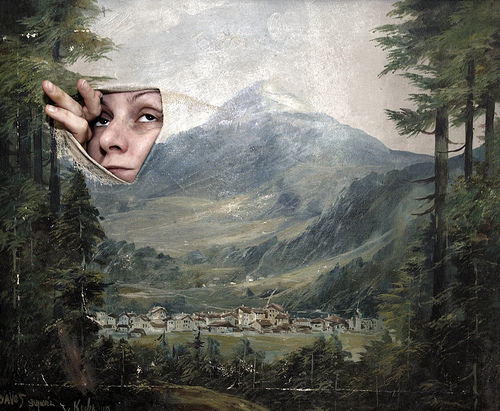Jun 21, 2012 | news
 |
| © Le Voyage à Nantes (via HuffPost) |
When Nantes, France shut down its shipyard– one of the biggest in the world, its young mayor decided to reinvent the city with contemporary art as its backbone.
This art is large-scale, massive even, and placed outside where everyone can see. Last year more than 200,000 tourists visited during the summer, and this year’s marketing campaign aims to draw 40,000 more.
There’s an 18th century stone house that looks like it’s being swept away by the Loire River, a 200-foot skeletal creature anchored to the beach that becomes more or less visible with the tide, plus a four-story mechanical elephant that took over the city’s abandoned docks.
For more on Nantes, check out the original story on Huffington Post Arts.
Jun 20, 2012 | film
 Although this movie came out last year, it only recently made it to theaters in my area. And even though I’m not too adept at movie reviews yet, Monsieur Lazhar deserves some description.
Although this movie came out last year, it only recently made it to theaters in my area. And even though I’m not too adept at movie reviews yet, Monsieur Lazhar deserves some description.
This film was sad in ways I wasn’t expecting, but not terribly depressing. Instead, the sadness was balanced by a poetic side that became more literal at the movie’s end. It wasn’t hard to like Lazhar, especially when his history as an Algerian refugee is revealed through scenes with his lawyer and the Canadian board of immigration.
Usually I prefer movies with a clear and defined plot structure, but this one was just ambiguous enough that I didn’t mind. It’s about the benefit of getting things out in the open, and how that’s the most important lesson Lazhar teaches his new students, even if their parents don’t agree. It doesn’t help to keep everything inside, no matter how normal you might seem to everyone else. This story of a Montreal classroom sharing an experience this heavy, as heavy as a teacher’s suicide, is somehow made uncomplicated and beautiful through simple shots and direct dialogue.
 It’s interesting how much emphasis Lazhar places on French pronunciation and dictation in his classroom, almost as if it parallels his desire for the students to be able to properly express themselves. His eagerness to get involved in the classroom therapy sessions is almost adorable, as he walks around outside the room when he’s rejected. Somehow, Lazhar understands things the other adults don’t: that you can’t truly compartmentalize your life when something this tragic happens to those so young. Even if he doesn’t attend the group therapy sessions in class, the kids will still be thinking about it once he’s rejoined them and begun the lesson. The only way to deal with grief is directly and together– not alone inside yourself; that’s what Monsieur Lazhar tries to teach us as we become students too.
It’s interesting how much emphasis Lazhar places on French pronunciation and dictation in his classroom, almost as if it parallels his desire for the students to be able to properly express themselves. His eagerness to get involved in the classroom therapy sessions is almost adorable, as he walks around outside the room when he’s rejected. Somehow, Lazhar understands things the other adults don’t: that you can’t truly compartmentalize your life when something this tragic happens to those so young. Even if he doesn’t attend the group therapy sessions in class, the kids will still be thinking about it once he’s rejoined them and begun the lesson. The only way to deal with grief is directly and together– not alone inside yourself; that’s what Monsieur Lazhar tries to teach us as we become students too.
 |
| From Slate Magazine’s review at Slate.com |
 |
| From NYTime’s review at movies.nytimes.com |
Jun 19, 2012 | news
A team of Italian researchers recently developed a new imaging tool that can capture features that would otherwise be undetectable. Thermal quasi-reflectography creates images using reflected light from the mid-infrared part of the spectrum.
The new imaging system was successfully tested on two famous works of art: the Zavattari frescos in the Chapel of Theodelinda and “The Resurrection” by Piero della Francesca. The tests revealed details missed by earlier tests and easily identified old restorations where missed gold decorations were simply repainted. In “The Resurrection,” TQR found an area around a soldier’s sword that was painted using two different fresco techniques that previously went unnoticed.
Rather than detect heat like traditional thermography techniques, TQR tries to minimize heat, shining a faint mid-infrared light source onto the surface of the painting. It then records the light that’s reflected back to the camera. It’s considered a “powerful yet safe tool for artwork diagnostics,” that better differentiates between materials in a painted surface.
Whatever we can do to keep these works around– art must outlive time:)
Read the rest of the original story on Market Watch here.
Jun 18, 2012 | inspiration
I find our representations of animals so interesting. If they could, what would they think about us replicating them for our own purposes?
What would my dog think if he knew every time I checked my phone I saw his little picture on my lock screen background?
Why do we ascribe certain characteristics to certain animals to the point where they become symbols of something entirely different?
I like to think they’d be flattered. Because all these beautiful little creatures are definitely worth drawing/painting/sculpting/describing.
Click the links in the captions for more by each artist.
 |
| Horse paper sculptures by Anna-Wili Highfield for Hermès found here. |
Jun 15, 2012 | inspiration
Happy happy weekend!
Do whatever you want to do and go wherever you want to go.
If you have a chance go here:
 |
|
David Hockney, Garrowby Hill, 1998.Found here. |




















